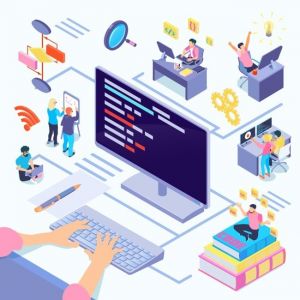 NGI offers grants to individuals and organizations to renovate the Internet Architecture reduce the technical (and energy) debt of the Internet and build open solutions for a better future. As the world confronts the COVID-19 crisis-driven demand for digital services for communications largely serviced by software giants’ solutions lacking security and privacy, NGI POINTER offers an alternative.
NGI offers grants to individuals and organizations to renovate the Internet Architecture reduce the technical (and energy) debt of the Internet and build open solutions for a better future. As the world confronts the COVID-19 crisis-driven demand for digital services for communications largely serviced by software giants’ solutions lacking security and privacy, NGI POINTER offers an alternative.
A sneak peek into the future
One could say that a peek into the future of Europe and the future of the Internet is the same thing, as they are tied together. Only by having a more human centric Europe can a more human centric Internet be achieved, and vice versa.
A sneak peek into the future of (potentially) disruptive technologies is presented by a collaborator of NGI Pointer with EC Future Emerging Technologies (FET) stakeholders: Project PREFET. FET lists 45 Trends for a long-term horizon (2025) with exploratory data visualization for the final 20 selected through a methodology that combines AI, human intelligence and expert consultations.
The identified trends, which will definitely influence the future of the Internet includes one which is intimately linked to ICT: Neuromorphic Computing & Ultra-efficient Biomimetic Computing AI. New Neuromorphic Computing and ultra-efficient Biomimetic computing power, and specifically AI computing power will enable new Edge capabilities for vision, audio and smart transducer applications that can increase applications for massive population testing. For example: artificial vision in super accurate temperature measurements, audio super early symptom detection or increased diagnosis of existing respiratory symptoms, and even smell. Triage of patients could also benefit from this trend.
Ultra-efficient Biomimetic hardware and AI could be an enabler precisely for portable diagnostics in countries and areas where access to big networks and energy sources for high computing capabilities is not an option (i.e. sub-Saharan Africa, and many other regions of the globe).
Future Emerging Technology trends
1. Early promise of artificial neurons to treat chronic diseases:
Our neurons only need 140 nano Watts of power. That’s a billionth the power requirement of a microprocessor, which other attempts to make synthetic neurons have used. This makes the neurons well suited for bio-electronic implants to treat chronic diseases and diagnostics to a new level.
2. Early research using a human brain-like net of deep learning neural networks:
An Oak Ridge National Laboratory method to improve the energy efficiency of scientific AI shows early promise in efforts to parse insights from volumes of cancer data. The researchers trained their network on clinical text data from the National Cancer Institute’s Surveillance, Epidemiology, and End Results (SEER) Program. By converting deep learning neural networks (DNNs) to “deep spiking” neural networks (DSNNs), they can improve the energy efficiency of network design and realization.
3. Work already exists in this direction in the COVID-19 crisis:
Graphen, together with Columbia University, is trying to define the canonical form of each gene localization of the virus, and identify the exact variant(s). It uses its Ardi AI platform which mimics the functions of the human brain to store these mutation data and visualize them.
4. Intel and Cornell University: Demonstrating Intel’s neuromorphic chip, Loihi, to learn and recognize 10 hazardous materials from smell — even in the presence of “significant” data noise and occlusion. This shows how neuromorphic computing could be used to detect the precursor smells to explosives, narcotics, polymers, and more.
However there are other such as Chemputing that offer a path towards digitalization of chemistry, and the democratization of at-home pharmaceutical synthesis via 3D printing, and making the digital (code) “recipes” shareable and open, which could open new paths to personalized medicine; and Biorobotics and bionics, where a team of international scientists highlights the role of robots in the current global pandemic, offering cost-effective solutions to contribute to the control of the spread.
Authors of the study “Combating COVID-19 — The role of robotics in managing public health and infectious diseases” include Shanghai Jiao Tong University; ETH Zurich; Texas A&M University; Stanford University; Sant’Anna School Pisa; UC Berkeley; Carnegie Mellon University and a dozen others. More intense collaboration between robots, and humans with enhanced (robotic) capabilities together with biologically inspired robots, can relieve the pressure from health workers dramatically. DIH Hero is in fact working on open calls along these lines for existing research and solutions in robotics (not necessarily bio-robotics & bionics).
NGI POINTER: anticipating and developing FET
Right now, digital transformation in many organizations is driven by the crisis, not strategy. The tools and options available are not built for scale on the existing internet architecture, adding organizations and users at this unprecedented scale to these systems causes problems at the infrastructure level. Solutions are only investigated at the application layer. NGI POINTER investigates options that suit the requirements, including decentralized, P2P tools that are inherently more privacy focused. NGI POINTER also investigates problems at the architecture level not trying to solve application issues in order to avoid increasing the technical (and energy) debt being generated.
NGI POINTER has an open call for architects to change the underlying fabric of the Internet and Web, closing 1 June. For more information click here.
For more information on NGI POINTER, see: pointer.ngi.eu/

